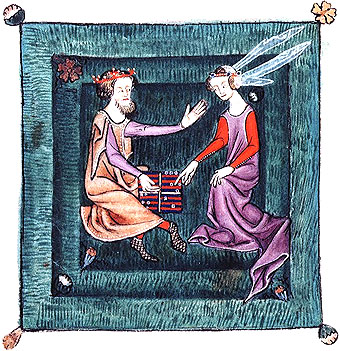|
| Magriel's NYT Columns |
 A popular form of backgammon is the chouette, which enables more than two players to participate in the same game. A chouette is a rotation system, in which one player, “the man in the box,” faces all the other players combined as a team.
A popular form of backgammon is the chouette, which enables more than two players to participate in the same game. A chouette is a rotation system, in which one player, “the man in the box,” faces all the other players combined as a team.
One member of the team, the captain, rolls the dice and has final authority on all moves, but the other members may consult. Indeed, it is not uncommon for spirited discussions to arise when the team must make a critical play.
The diagrammed position occurred recently in a chouette at the Park 65 Backgammon Club. The lead in this game had changed hands several times. Black (the team) had just doubled to the 8-level and White (the box) had bravely accepted. Although White was ahead in the race, he still had one man in Black’s home board. To win, Black had to prevent this man from escaping.
|
| Black to play 6-5. |
They reasoned that their play was safer and gave White less chance for an immediate winning roll. If Black hits, White has 14 combinations (out of a possible 36) to hit back (11 direct 4’s, 3-1, 1-3, and 2-2). If Black makes the 2-point, White has 11 combinations to roll a direct 6 and escape.
A chouette, however, is not a democracy. The team captain overruled the majority’s wishes and hit, 9/4*, 9/3. Unfortunately for the team, White rolled a 4-2 and hit Black back on the 4-point. White happily redoubled to the 16 level and the entire team was forced to give up. One disgruntled player muttered, “I’ll never understand how anybody could leave a direct shot against a closed board.”
Despite the result, the captain’s play, 9/4, 9/3*, was correct. This play gives Black the best overall chance of winning the game. The conservative faction’s argument against hitting is fallacious because it fails to consider the follow-up to each play. Consider what happens in each case if White does not roll an immediate winning shot.
With the correct play, White misses on 22 combinations (36 − 14 = 22). Black can then easily cover the 4-point to form a full prime. Thus, Black definitely has better than a 50 percent chance to win the game.
With the other play (making the 2-point), White fails to roll a 6 with 25 combinations (36 − 11 = 25). Even though White has not escaped, he still retains considerable winning chances. Black still must worry about containing White and preventing him from running later. Indeed, a detailed analysis shows that White will still win about 7 of these 25 times. Thus, the “safe” play gives White approximately 11 + 7 = 18 chances to win — exactly even!
Rollout
 Tom Keith 2013 |
|
Money play White owns 8-cube Black rolls 6-5 1296 games with VR Checker play: 2-ply Cube play: 3-ply Red |
| 6-5: | Game | G | BG | Equity | ||||
| 1 | 8/2, 7/2 |
W L |
.5566 .4434 |
.0193 .0150 |
.0005 .0001 | +0.0193 |

| (a) |
| 2 | 9/3, 9/4* |
W L |
.5681 .4319 |
.0289 .0975 |
.0006 .0002 | +0.0042 | (0.0151) | (b) |

|
|

